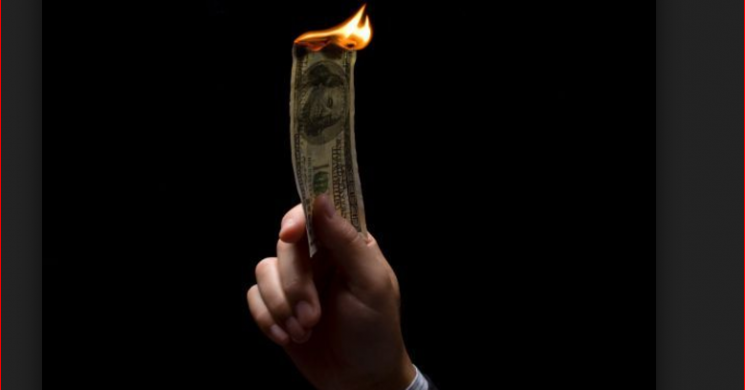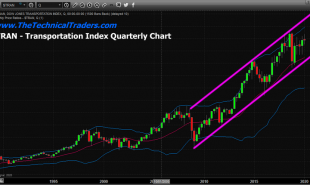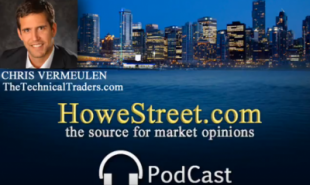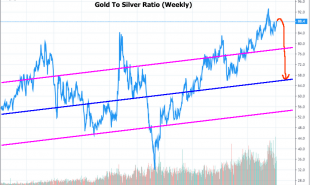
Cheer up, Charlie
So have no fear, Charles Evans. The dollar is but a piece of paper. The Fed holds the lit match.
Intro - While Charles Evans mused yesterday about the deflationary effects of technology, we have our own take that is not incompatible with what Philip Grant states below. First: YES, tech will cause ever more deflationary pressures on consummables as we optimize production and logistics to the next level using tech. But the tech coin's economic effect has 2 sides. And we are just beginning to reap the other side which relates to labor
But this is a race to the bottom now. Sure consumer prices are dropping, but so is pay and employment from displaced industries. That is nothing new, as capitalism is based on creative destruction and competition. We welcome that. What is disconcerting is the horrendous management of societal expectations we see now. Noone has expected to tighten belts for years. And this has been fomented with easy money and credit. The American standard of living has not suffered at all relative to the conveniences it has enjoyed at the hands of the tech revolution. Here are the 3 reasons that a deflationary crisis is a real possibility in our opinion. Simply put:
-
Technology - reduces the cost of goods produced, and need for human labor
-
Economically - and tied to Tech, the reduction in labor and wages is a necessary effect of applied technologies = zombie consumers
-
Government- has enabled the U.S. consumer to leverage themselves to the point now where what money they are making is going towards servicing debt
So while the Government and FOMC fret about why they are not able to inflate their way out of this one (yet), our point is that in a race to the bottom between cost of goods and wages, wages are starting to catch up (deflate) and that is how things should be.
The Fed will do everything it can to inflate including potentially just giving money to people to get them to spend again. This is what helicopter money actually originally meant. And this is what the Amazons of the world are forcing to happen. Consumers are leveraged to the hilt, debt service is eating up much of their paycheck, and the work force is not trained for future jobs. This is what government intervention does. Whether in the form of easy money, or fiscal irresponsibility, it prolongs the inevitable.
The markets have been prohibited to self clearing means. The result is too many people on the Gov't Teat and too many corporations dependent on that teat to keep producing milk. And pot oddsdicate there will be no meaningful changes in policy to clear out the markets organically. At least not until the boomers are mostly out.
Speculatively Speaking : If the Fed cannot inflate and devalue it and its citizen's debt it will go fiscal and rain money on people. If that fails to get people buying more crap from Bezos et al, then it is war. Bank on it. War is the only way the Govt gets control (temporarily) back from corporations and gets people to lower standards of living.
There will be massive inflation. It just may be the result of a panic to stave of technologically driven deflation and our gov't's need to perpetuate the illusion that the American Dream is more than just a dream. And that denial will make the fire the inflationary fire government starts even worse
Enjoy Philip Grant's Comments on Charles Evan's Worries.
Via Grant's Almost Daily
Chicago Fed President Charles Evans is on the lookout for lower prices. Not for his own shopping needs, mind you. Instead, the specter of the monetary boogeyman known as deflation evidently haunts the Federal Open Market Committee voting member. In a CNBC interview yesterday, Evans noted the stubbornly low level of measured inflation in recent years, stating:
We’ve said that 2% [annual inflation] is our objective, [and] that it’s symmetric, and I think we need to follow through on that. So I think we need to average 2% for a long enough period of time…The most recent inflation data, makes me a little nervous.
Evans went on to identify a likely culprit for this-too slow pace of inflation: technological progress. Citing the recently announced Amazon acquisition of Whole Foods Market, he said:
We know that technology is disruptive. It’s changing a number of business models that used to be very successful, and you have to wonder if certain economic actors can continue to maintain their price margins, or if they are under threat from additional competition. And that could be an undercurrent for holding back inflation.
If sub-2% inflation makes Evans and Co. shudder, we wonder what emotional scars the experience of the late 19th Century would have visited on a hypothetical FOMC (the Fed was still decades away from existence). According to economists Nathan S. Balke and Robert J. Gordon, the years 1866-1899 saw only two annual periods of positive inflation (1880 and 1887); five times in that period did the price index decline by more than 4%, twice by more than 6%.
Then, as now, technological advance figured prominently. That era included the invention of the telephone, typewriter, dishwasher, internal combustion engine, paper-strip photographic film, steam turbine, barbed wire, wearable contact lenses and traffic lights, among many other features of modern life.
With greater productivity came lower prices, and with lower prices came a higher standard of living. David Ames Wells’ 1890 book “Recent Economic Changes - And Their Effect on the Production and Distribution of Wealth and the Well-Being of Society” notes that:
In the United States the daily wages paid, or the daily earning capacity of a healthy adult worker, in even the most poorly remunerated employments, is more than sufficient, if properly expended, to far remove the recipient from anything like absolute want, suffering or starvation.
It is no understatement to say that the 1913 founding of the Federal Reserve was a seminal turning point in the economic history of the United States. According to the Westegg inflation calculator found online (with data derived from the 1975 Historical Statistics of the United States), goods and services which cost $100 in 1800 would have cost only $58.10 in 1913. By contrast, the Bureau of Labor Statistics’ own CPI inflation calculator (which only goes back to 1913) calculates that what would cost $100 in 1913 would now command $2,497.65 today.
So have no fear, Charles Evans. The dollar is but a piece of paper. The Fed holds the lit match.
CLICK HERE to begin a six-issue Trial Subscription to GRANT'S. Offer ends June 24, 2017.
Read more by Soren K.Group







